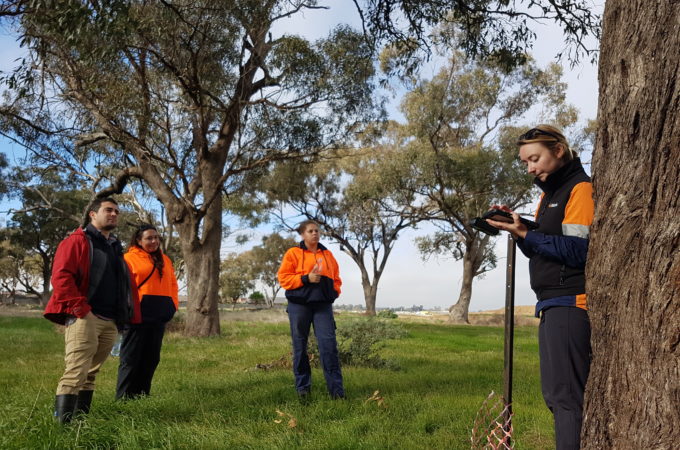
31/07/2017
VPA walks the land with Yorta Yorta and Biosis
VPA planners were delighted to join Biosis archaeologist Kym Oataway and Yorta Yorta Nation site monitors Vanessa Charles and Jarnali Bux recently to walk the land in Echuca West.
The planners met with the trio on 23 June, searching for artefacts, Scarred Trees and other items of Aboriginal heritage significance.
The Shire of Campapse and VPA are planning for a new urban area for the site, and the walk was part of an initial cultural heritage assessment. The VPA and council recognise the importance of consulting with traditional owners early on in the planning process, to ensure our plans are sensitive to Aboriginal cultural heritage.
Tim Lolicato, who is working with council to prepare the Echuca West Precinct Structure Plan (PSP), said that walking the land with traditional owners and Biosis was a valuable experience.
“Seeing the Scarred Trees up close, with the understanding that they have been preserved from a time before European settlement was important,” Tim said.
“It helps put in perspective the Yorta Yorta peoples’ history with this area.”
Tim also said it was interesting to hear Kym’s professional assessment of the site. As an archaeologist she was able to scan the landscape and have an immediate understanding of its nuances. This includes an assessment of how the land was used by Aboriginal people to sustain themselves how the landscape had changed since agricultural practices were introduced.
“You learn to read the landscape and what you’re looking for,” Kym says.
Kym explains that when she finds an artefact or Scarred Tree, she records these on a Differential GPS device, which pinpoints its exact location on a map.
Kym says that before GPS technology, the location of items of Aboriginal significance were recorded using compass points – an inexact science. These days, however, the Differential GPS devices are accurate to within one metre of a site, allowing planners and developers to rely on this data with confidence.
While the VPA only joined them for one day, Vanessa, Kym and Jarnali walked 356 hectares of the 800-hectare precinct over the course of a week.
Biosis is now writing a background report on the state of the land and areas of potential Aboriginal significance, which the Yorta Yorta Nation Aboriginal Corporation will review. The report will also make recommendations for any additional detailed work that may be required for the area.
The VPA and council will refer to the Biosis report when preparing the precinct plan for the area. The precinct plan will illustrate ways in which developers could protect any significant areas and enforce further investigation if required. This is standard practice across all of the authority’s PSPs.
Later down the track, once the PSP has been approved, developers are typically required to produce a cultural heritage management plan for the site. It’s during this stage that more detailed site assessments will take place, including excavations if required.
Developers will then consult with the Yorta Yorta Nation Aboriginal Corporation to create meaningful responses to identified cultural heritage places, such as preserving areas for open space.
Vanessa explains the value of engaging with traditional owners through every step of the planning process.
“It’s extremely important because it’s preserving heritage, maintaining culture and it shows how long our connection with this country is.”
